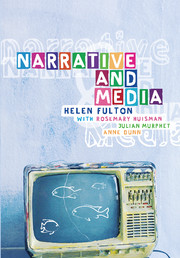Book contents
- Frontmatter
- Contents
- Figures and tables
- Contributors
- Acknowledgements
- 1 Introduction: the power of narrative
- Part 1 The basics of narrative theory
- Part 2 Film as narrative and visual mode
- Part 3 Television: narratives and ideology
- Part 4 Radio and print journalism
- Part 5 Popular print culture
- Glossary
- Bibliography
- Index
1 - Introduction: the power of narrative
Published online by Cambridge University Press: 05 June 2012
- Frontmatter
- Contents
- Figures and tables
- Contributors
- Acknowledgements
- 1 Introduction: the power of narrative
- Part 1 The basics of narrative theory
- Part 2 Film as narrative and visual mode
- Part 3 Television: narratives and ideology
- Part 4 Radio and print journalism
- Part 5 Popular print culture
- Glossary
- Bibliography
- Index
Summary
In a world dominated by print and electronic media, our sense of reality is increasingly structured by narrative. Feature films and documentaries tell us stories about ourselves and the world we live in. Television speaks back to us and offers us ‘reality’ in the form of hyperbole and parody. Print journalism turns daily life into a story. Advertisements narrativise our fantasies and desires.
As long as human beings have had the power of speech, they have been speaking in narratives, goes the theory (O'Shaughnessy & Stadler 2002: 127). Yet there is nothing natural or universal about narrative, which is a form of representation. As such, it is historically and culturally positioned to turn information and events into structures that are already meaningful to their audiences. Since the media are now the major controllers of narrative production and consumption in the Western world, the stories that seem the most ‘natural’ are the ones to which the media have accustomed us.
This book is about the ways in which contemporary media structure narrative and how the processes of production and signification that characterise media narratives can be theorised. Beginning with a historical survey of narrative theory, which focuses on structuralism and its post-structuralist responses (chapters 2 and 3), the book then examines film as a major producer of narrative (chapters 4 to 9).
- Type
- Chapter
- Information
- Narrative and Media , pp. 1 - 8Publisher: Cambridge University PressPrint publication year: 2005
- 3
- Cited by



